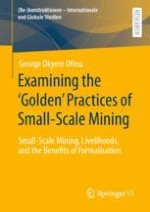Scholarship on artisanal and small-scale mining (ASM) has often portrayed mining regions as ‘informal’ zones that suffer from environmental degradation problems. Water pollution and degraded landscapes, for example, have long been noted as the inevitable consequence of the operations of ASM. Such insistence on the institutional absences of ASM zones has dovetailed with a lack of academic attention to some of the ‘golden’ mining practices taking place there. Thus, this work seeks to (re)examine the topic of ‘development’ in ASM. The findings suggest that small-scale miners, contrary to popular perception, could be caretakers of the environment. In addition, emphasizing how the dynamic interplay between resources and environmental demands may come to support public policy, the findings illustrate, contrary to the dominant narrative, how the activities of small-scale mining operators can engender a win-win situation for both mining companies and local mining communities.
